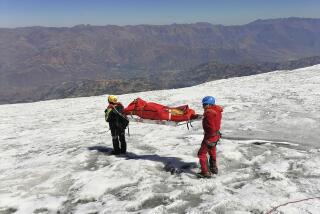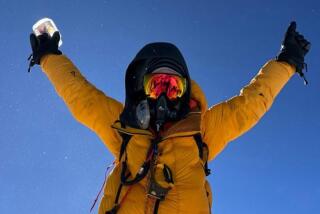Forever Everest
Nearly 50 years ago, on May 29, 1953, Edmund Hillary and Tenzing Norgay, weary of body and mind but driven by a desire that burned deeper by the day, left their exhausted climbing party behind and marched to the top of the world.
As they stood where no man had ever stood, in the thinnest of air on the 29,035-foot summit of Mt. Everest, they knew that what they had just accomplished was incredible.
For the record:
12:00 a.m. April 30, 2003 For The Record
Los Angeles Times Wednesday April 30, 2003 Home Edition Main News Part A Page 2 ..CF: Y 1 inches; 47 words Type of Material: Correction
Moonwalk year -- It was incorrectly reported in a Sports article Saturday about the 50th anniversary of the first ascent of Mt. Everest that Neil Armstrong and Buzz Aldrin walked on the moon in 1972. Armstrong and Aldrin walked on the lunar surface on July 20, 1969.
But they had no way of knowing what it really meant.
“All they knew was that this had been an amazing opportunity,” says Peter Hillary, Sir Edmund’s son, who has twice set foot atop the world’s tallest mountain and who, like his still-active 83-year-old father, is obsessed with experiencing life beyond the boundaries of civilization. “Obviously, to become the first to climb the highest mountain on earth was going to be an extraordinary thing. But in today’s terms I think they had no idea.”
Today, the lure of Everest is far more powerful than anyone could have imagined. In the last 50 years, more than 10,000 people have attempted climbing’s greatest pinnacle. Seventeen-hundred have succeeded. An even 175 have paid the ultimate price, their bodies having found permanent refuge on Everest’s rugged slopes, adding to an already surreal landscape.
This in itself paints a telling picture. Hillary, a humble beekeeper from New Zealand, and Norgay, a yak herder from Nepal, did something seven major expeditions dating more than 30 years couldn’t do.
They opened Everest to the world.
At a time when humanity was still reeling from the destruction of World War II, they showed that with hard work, determination and perseverance, people can realize their dreams, no matter how impossible they may seem.
Peter Hillary compares the first steps on Everest’s summit to those on the moon 19 years later, taken by Neil Armstrong and Buzz Aldrin. Both events represented a giant leap for mankind. Both had a lasting impact on society.
“I imagine it was one of those things that makes people, right now in 2003, so different from people back around the turn of the [20th] century,” says Hillary, 48, an adventure travel company owner in Auckland. “I think your average person in 1900 was quite confined. I think they felt, ‘I’ll just work on my father’s farm, or shoe business or whatever it might be.’ And that was kind of their outlook.
“In 2003, our young people know they can do anything. They could be anywhere. My kids could live in New York City. They could go on a space mission. They could set up their own business. My daughter has incredibly ambitious views of where she’s going to be, and they’re all possible. And I believe a lot of that is because, during the 20th century, a series of events just showed that ordinary people can do extraordinary things.”
Tenzing Norgay went on to become an ambassador for the Sherpa people, attaining almost mythical status. He died of a brain hemorrhage in 1986.
Sir Edmund Hillary -- his reward was knighthood, courtesy of England’s Queen Elizabeth II -- never went back to the top. But he continued to climb extensively throughout the Himalayas, where he developed a close relationship with the Sherpas and helped them build hospitals, clinics and schools.
In 1957, he established New Zealand’s first Antarctic base on Ross Island. A year later, he led a caravan of converted farm trailers, becoming the third person to reach the South Pole overland after Roald Amundsen in 1911 and Capt. Robert Scott in 1912.
In 1977, he led a jet-boat trip up the Ganges River from the Bay of Bengal to the Hindu shrines in the Himalayas. In 1985, he flew in a small plane to the geographic North Pole. With him were Armstrong the astronaut, Stephen Fossett the billionaire balloonist, and Peter Hillary the budding adventurer.
From that day forward, the son was no longer content living vicariously through his father, who could not be reached for comment, and his friends.
“I’ve become enamored with the great outdoors and that lifestyle,” Hillary, a happily married father of four, announced during a recent interview. “And I’ll not stop till I’m stopped.”
*
Peter Hillary was in Los Angeles recently promoting a documentary called “Surviving Everest,” part of the National Geographic Society’s commemorative countdown to the 50th anniversary of the first ascent.
The expedition, last May, involved Hillary, Tenzing Norgay’s son, Jamling Tenzing Norgay, and Brent Bishop, son of the late Barry Bishop, who in 1963 was part of the first successful American expedition to reach the summit. (Barry Bishop died in a 1994 car accident.)
Leading the expedition was Pete Athans, whose seven successful summit attempts are more than any other Westerner.
The two-hour documentary, to be shown Sunday at 8 p.m. on the National Geographic Channel, is an extraordinary piece of work that uses the expedition as its centerpiece, while shifting intermittently from past to present. The footage is spectacular and the characters real. If nothing else, viewers are left with a clear understanding of the dynamics of the mountain, and the impact it has had on climbers and the Sherpa people.
Before the arrival of the mountaineers, Sherpas did not venture high onto Everest slopes, for fear of falling out of grace with the “Goddess Mother of the World.” But they were a poor community of farmers and livestock ranchers, and in the Westerners they saw opportunity.
They hired on as porters, hauling gear from Katmandu, Nepal, to base camp at 17,600 feet, and also as climbers handling various chores on the mountain. Today, trekking and mountaineering is a thriving industry, drawing 27,000 visitors annually.
The price tag for prosperity: Of the 175 fatalities on Everest, 56 involved Sherpas.
Jamling Tenzing Norgay was forbidden to climb and did so only after the death of his father. In an interview this week, he said it was done not out of disrespect but “to pay homage to my father by trying to understand what he was thinking, and what he had gone through.”
That was in 1996, the deadliest year on Everest, one in which nine climbers died in a single day, when a blinding, whiteout storm caught four groups off guard at 29,000 feet. Among those killed were famed mountaineers Rob Hall and Scott Fischer.
Norgay was part of the IMAX expedition that had attained the summit, only to become involved in a rescue effort on a chaotic day that so vividly illustrated the most dangerous downside to Everest’s popularity. There are no restrictions as to who can or cannot climb. It is open to any seven-member group that comes up with the $70,000 permit fee and overcrowding remains a serious problem.
Norgay was honored for his bravery, but vowed never to climb again and chose to remain at base camp, acting as communications expert, for the “Surviving Everest” expedition.
That expedition featured Hillary and a team of Sherpas attempting the South Col, or Southeast Ridge route pioneered by his father. Meanwhile, Bishop and Athans tried the more daunting West Ridge route, which has been attempted 40 times but climbed successfully only six times, with 23 climbers dying along the way.
Overall, the two-pronged expedition was as uneventful as an Everest expedition can be.
Strong winds forced abandonment of the West Ridge attempt, Bishop and Athans joining the other team back at base camp, where it had returned to prepare for its summit charge after its acclimation forays to various camps on the mountain.
A film crew was nearly killed when hulking blocks of ice collapsed on the infamous Khumbu Icefall. Hillary, at one point, became ill and had to return to base camp to recover, jeopardizing his effort. The entire expedition was nearly called off when high winds above 25,000 feet forced another retreat.
“In a way, that’s the beauty of going on a major expedition,” Hillary said. “In spite of the knowledge and experience of all the team members, it’s not a done deal until you’re standing on the summit.”
The assault on the summit, from the South Peak at 27,800 feet, was eventually carried out. Hillary, who’d lost two climbing partners who hurtled past him while they were attempting the West Ridge route in 1996, had to negotiate past another fallen friend in Hall, with whom he’d climbed Everest for the first time in 1990.
Hall’s body lies buried 100 feet below the South Summit, which is connected to the main summit by a sharp ridge with a sheer cornice to the right and a long, steep drop-off to the left.
Fischer’s body, which is sometimes visible to climbers, is farther down at about 27,500 feet.
“You look around and there’s this really wind-rotted sculpted snow,” Hillary said. “And there are the necks of a few abandoned oxygen bottles sticking out of the snow. And you know that lying beside one of those is Rob Hall and it’s very haunting. I’m just very pleased that we couldn’t see either Scott or Rob.”
Once on the summit, 5 1/2 miles above sea level, they could see much of India, Tibet and Nepal, as part of a breathtaking, almost otherworldly panorama.
It was an emotional moment for Hillary, who felt a special connection with his father. So he did something his father never could have: He pulled out a satellite phone and called him.
More to Read
Sign up for The Wild
We’ll help you find the best places to hike, bike and run, as well as the perfect silent spots for meditation and yoga.
You may occasionally receive promotional content from the Los Angeles Times.






